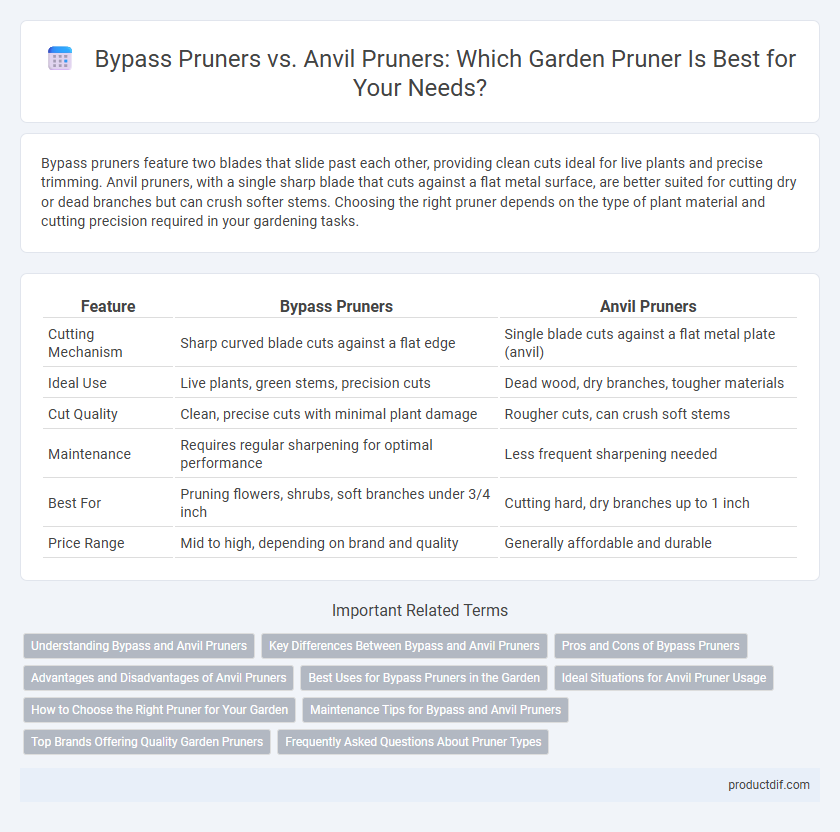Bypass pruners feature two blades that slide past each other, providing clean cuts ideal for live plants and precise trimming. Anvil pruners, with a single sharp blade that cuts against a flat metal surface, are better suited for cutting dry or dead branches but can crush softer stems. Choosing the right pruner depends on the type of plant material and cutting precision required in your gardening tasks.
Table of Comparison
| Feature | Bypass Pruners | Anvil Pruners |
|---|---|---|
| Cutting Mechanism | Sharp curved blade cuts against a flat edge | Single blade cuts against a flat metal plate (anvil) |
| Ideal Use | Live plants, green stems, precision cuts | Dead wood, dry branches, tougher materials |
| Cut Quality | Clean, precise cuts with minimal plant damage | Rougher cuts, can crush soft stems |
| Maintenance | Requires regular sharpening for optimal performance | Less frequent sharpening needed |
| Best For | Pruning flowers, shrubs, soft branches under 3/4 inch | Cutting hard, dry branches up to 1 inch |
| Price Range | Mid to high, depending on brand and quality | Generally affordable and durable |
Understanding Bypass and Anvil Pruners
Bypass pruners feature two sharp blades that pass each other like scissors, making clean cuts ideal for live plants and precise pruning. Anvil pruners have a single sharp blade that closes onto a flat, anvil-like surface, designed for cutting through tougher, dead wood but can crush softer stems. Selecting the right pruner depends on the plant material; bypass pruners offer accuracy for healthy branches, while anvil pruners provide power for dense, woody stems.
Key Differences Between Bypass and Anvil Pruners
Bypass pruners feature two curved blades that pass by each other, creating a clean cut ideal for live branches and precise pruning. Anvil pruners have a single straight blade that crushes plant material against a flat metal plate, making them suitable for cutting dry or dead wood. Key differences include cutting mechanism, precision of the cut, and preferred uses based on plant health and branch thickness.
Pros and Cons of Bypass Pruners
Bypass pruners feature two sharp blades that pass by each other, providing clean cuts excellent for live plants and minimizing damage to stems. Their design reduces crushing, promoting faster healing and healthier plant growth, but they require regular sharpening and can be less effective on tougher, woody branches. Lightweight and precise, bypass pruners are ideal for gardeners focused on maintaining the vitality of delicate plants and flowers.
Advantages and Disadvantages of Anvil Pruners
Anvil pruners feature a single straight blade that cuts against a flat metal surface, providing a strong and precise cut ideal for dead or dry branches. Their design is less suitable for live plants because the blade can crush softer stems, potentially causing damage. While anvil pruners excel in durability and leverage, they tend to be less clean-cut compared to bypass pruners, limiting their use for delicate gardening tasks.
Best Uses for Bypass Pruners in the Garden
Bypass pruners are ideal for precision cutting of live plants, cleanly slicing through green stems and branches without crushing the tissue, which promotes faster healing and reduces plant damage. They excel in pruning roses, shrubs, and herbaceous plants where accurate cuts preserve plant health and encourage vigorous growth. These pruners are essential for gardeners aiming to maintain healthy, well-shaped plants and prevent disease spread through clean cutting.
Ideal Situations for Anvil Pruner Usage
Anvil pruners excel in cutting through dry, dead branches and tough, woody stems due to their single straight blade that presses against a flat anvil, providing strong leverage and minimal blade wear. They are ideal for gardeners dealing with dense, fibrous material where clean cuts are less critical, such as pruning hard or dead wood in flower beds and landscaping shrubs. Their simplicity and durability make anvil pruners a preferred choice for heavy-duty pruning tasks in garden maintenance.
How to Choose the Right Pruner for Your Garden
Bypass pruners feature two curved blades that slide past each other, providing clean cuts ideal for living plants and green stems, reducing damage and promoting faster healing. Anvil pruners have a single straight blade that cuts against a flat metal surface, suited for tougher, dead wood but can crush softer branches and may cause more damage. Choose bypass pruners for precise cuts on healthy growth, while anvil pruners are better for heavy-duty pruning of woody, dry materials in your garden maintenance.
Maintenance Tips for Bypass and Anvil Pruners
Bypass pruners require regular blade sharpening and thorough cleaning to prevent sap buildup, ensuring precise, clean cuts that promote plant health. Anvil pruners benefit from blade alignment checks and occasional oiling to avoid rust and maintain effective crushing cuts on tougher branches. Proper storage in a dry place and periodic tightening of screws extend the lifespan and performance of both types.
Top Brands Offering Quality Garden Pruners
Top brands offering quality garden pruners include Felco, known for their precision bypass pruners with sharp, replaceable blades and ergonomic designs. Fiskars delivers durable anvil pruners featuring rust-resistant steel and comfort grips ideal for cutting tough branches. ARS combines craftsmanship and innovation, providing both bypass and anvil pruners that ensure clean cuts and long-lasting performance for various gardening tasks.
Frequently Asked Questions About Pruner Types
Bypass pruners feature two sharp blades that pass each other like scissors, making them ideal for clean cuts on live plants and green branches. Anvil pruners have one sharp blade that closes onto a flat, softer metal surface, suitable for cutting tougher, dry, or dead wood but may crush softer stems. Gardeners often ask which type delivers cleaner cuts and longer tool life, with bypass pruners favored for precision and anvil pruners preferred for heavy-duty tasks.
Bypass pruners vs Anvil pruners Infographic

 productdif.com
productdif.com